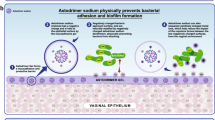Abstract
Treatment options for bacterial vaginosis (BV) include oral and topical formulations of metronidazole or topical formulations of clindamycin. Opinions of a new vaginal suppository form of clindamycin, administered for 3 days, were obtained in a survey of 96 women who had been generally satisfied with their previous treatment. Following manipulation of the clindamycin ovule and metronidazole vaginal gel, more respondents expressed a preference for the ovule (52% vs 47%), and 54% preferred the ovule to the gel (44%) for possible future use. The gel was rated easier to use, but the ovule was found to be less messy. After manipulating both products, respondents read a profile of the ovule and identified the 3-day course as its most beneficial feature, citing this reason as increasing their likelihood of completing therapy with the ovule than with the gel. Approximately three fourths of the respondents who initially preferred the gel switched their preference to the ovule after reading the product profile. At that point, 86.5% of all respondents preferred the ovule. These results suggest the potential for improved compliance with therapy for BV with the clindamycin ovule.
Similar content being viewed by others
References
Sobel J. Vaginitis.N Engl J Med. 1997;337:1896–1903.
Centers for Disease Control and Prevention. 1998 Guidelines for treatment of sexually transmitted diseases.MMWR. 1998;47(No. RR-1):1–118.
Benrubi G. BV: diagnosing and treating the most common vaginal infection.Female Patient. 1999; 24(suppl):4–8.
Hillier S, Holmes KK. Bacterial vaginosis. In: Holmes KK, Mårdh P-A, Sparling PF, et al, eds.Sexually Transmitted Diseases. 2nd ed. New York: McGraw-Hill; 1990:547–559.
Majeroni BA. Bacterial vaginosis: an update.Am Fam Physician. 1998;57:1285–1289.
Faro S, Apuzzio J, Bohannon N, et al. Treatment considerations in vulvovaginal candidiasis.Female Patient. 1997;22:39–56.
Data on file, Pharmacia & Upjohn Company, Peapack, NJ.
Author information
Authors and Affiliations
Rights and permissions
About this article
Cite this article
Broumas, A.G., Basara, L.A. Potential patient preference for 3-day treatment of bacterial vaginosis: Responses to new suppository form of clindamycin. Adv Therapy 17, 159–166 (2000). https://doi.org/10.1007/BF02853158
Issue Date:
DOI: https://doi.org/10.1007/BF02853158




